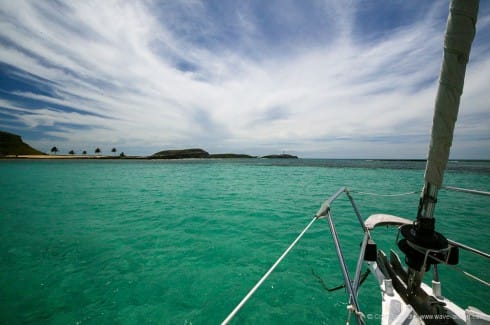
We’re often asked whether we make much use of our lifting keel and rudder, and the answer is always an unequivocal “Yes”! Having real shoal draft capability (0.8m with board and rudder up) is a huge plus, not just for exploring rivers and creeks but also sheltered bays and islands, and we take full advantage of it.
It sometimes gives other people a shock to see a boat of Pèlerin’s size in such shallow water, and other crews often think we’re either aground or just about to be.
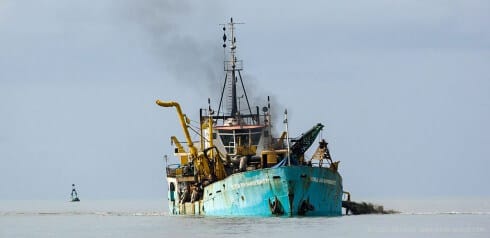
And sometimes it comes into good use when you least expect it. Leaving the peaceful river at Caravelas, we got a surprise to find a big dredger hard at work in the main channel out between the sandbanks, leaving virtually no room to spare between the channel markers. Normally this entails a kind of ‘heart-in-mouth’ experience as you sneak around the markers trying to find enough water to get by, but not for us, as we just pump up the keel and rudder and slip by unhindered.
Rivers and Islands
Exploring the rivers here in Brazil has been a wonderful experience so far, but equally we’ve been looking forward to visiting some of the islands. For us, rivers are the arteries that enable you to reach the heart of a country, whilst islands more reflect the spirit of adventure required to go and stay there.
Most of all, we like the islands where man’s footprint is not too deeply embedded, and nature still reigns. So we weren’t about to miss the National Park of the Arqipélago dos Abrolhos 35 miles out from Caravelas, especially with a settled forecast.
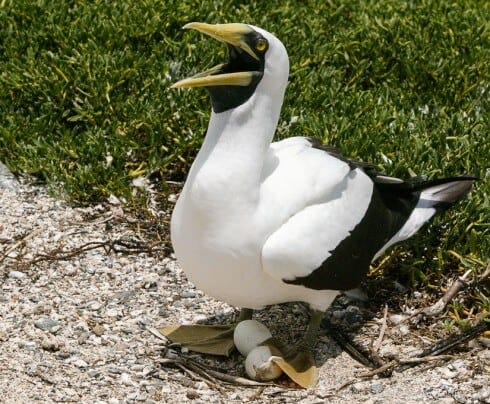
The name of the islands is believed to derive from the old Portuguese ‘abra los oyos’ – keep your eyes open, and they weren’t kidding. A group of tiny islands of volcanic origin, they are surrounded by a plateau of shoals and reefs that have claimed many vessels over the centuries. Of the five islands, only the largest, Ilha Santa Barbara, is currently inhabited, by a small naval garrison who operate and maintain the lighthouse, and a group of volunteers and researchers who work for the National Park. The rest are left to their original inhabitants, masked and brown boobys, frigate birds and red-billed tropic birds.
Paper Parks?
National Parks of this nature can often be a disappointment, in that really they only exist on paper, and as a result are as barren as the inshore coastline. But that isn’t the case here, where there is a fisheries no-take zone around the islands, with the result that snorkelling around the reefs is a real delight, with a fantastic diversity of fish species, many of sizes that I haven’t seen in years.
Landing is only permitted on one island, Ilha Siriba, and even then only in the company of one of the Park’s staff. Mooring buoys have been installed in the main bay on Santa Barbara, and between Ilha Siriba and Ilha Redonda, for visitors and dive boats to use (to protect the coral), but anchoring is still permitted as long as it is only in sand, not on coral.
Due to previous bitter experience, anchoring is always the preferred option for us, so we worked our way in to a big patch of sand, and with boards up anchored in a shallow lagoon in gin clear water, with turtles and rays beneath us for company—shoal draft wins out again.
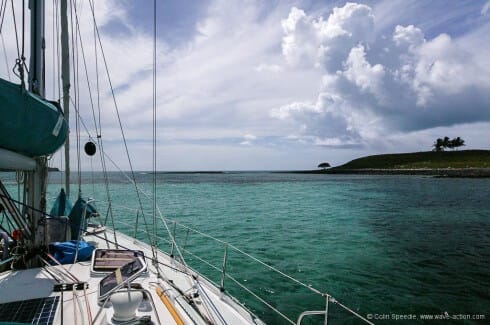
Lonely Places
Tiny islands like these, away out in the Atlantic, have a strange appeal, driven equally by their simplicity and seclusion and a desire to live on the edge a little. There is really no shelter to speak of, and the slow breathing of the South Atlantic ensures that there is always a swell.
When I asked one of the naval staff what it was like there in a storm, he sounded and looked genuinely scared—and that’s ashore! Like the Blaskets off Ireland or St Kilda in Scotland, if you’re sensible you only visit when everything is in your favour, if you’re to get any sleep at all. As the great Bill Tilman was fond of remarking, these are places where you feel about as safe “as the mouse that dwelt in the cat’s ear”.
Watching the Weather
I’m of an age before the internet was even dreamt of, and grew up in a seaside community where local fishermen read the weather via the signs in the sky, and taught us kids what to look out for. As young sailors we thought it was the height of sophistication to have the BBC Radio 4 weather forecast four times a day, hard to believe in this day and age when we can simply call up the GRIBs via satellite phone. But there’s an old soul in me that doesn’t entirely trust all this new-fangled stuff, and scans the sky for the tell tale signs of a change on its way, especially when we’re anchored in such a tenuous, elemental place.
So when the mare’s tails started to appear, I was soon scanning the GRIBs for evidence of a change coming. Nothing. Looked fine, so we let out a little more chain and relaxed again. The following morning the sky looked the same but the swell was more urgent, which I didn’t like either, and we decided to shift anchorage late in the day to get more shelter behind Santa Barbara. But a combination of the swell and mildly jangling nerves didn’t let us get much sleep, so at first light we made tracks south.
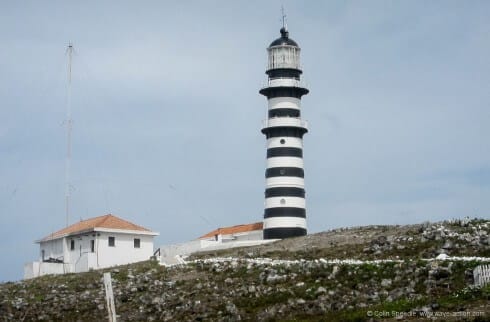
And the Weather Outcome?
No big deal, although the wind did get up to 25 knots in the approaches to Vitoria. And then the wind went round to the south as a cold front came up from Argentina, which enabled me to (ahem!) claim ancient wisdom, whether rightly or wrongly.
But it did make me think – how many of today’s generation watch the weather the way us old timers do? And is it necessary? After all, most of us rely almost entirely on GPS for navigation these days, and we accept that without question. Maybe we can rely almost as much on computer generated weather in the same way?
But if it is the case that weather lore is a thing of the past, I can’t help thinking that something will have been lost in terms of our craft, and—perhaps—some of the animal spirit that drove so many of us out there in the first place (and kept us safe) with it, too.

Colin,
Nice essay. For a couple of seasons we were in the Bahamas and I did a regular SSB weather report (real time, not forecast) with my crib sheets in hand including cloud pictures. I learned a lot. We missed clouds a great deal for the years in the Med, but are making up for those completely sunny days for the last year or so by being in the UK.
Dick Stevenson, s/v Alchemy
Hi Dick
Sailing around Britain is crash course in how to read the arrival, progress and departure of a North Atlantic weather system, as you’re no only too well aware!
What I struggle with now we’re on the other side is what to make of what I see – and whether it has serious implications for us, or not, when it might arrive etc.
I remain convinced that this is still a vital and viable way to watch the weather – and it’s a lot more fun than looking at GRIB’s however good they are.
Best wishes
Colin
Colin, I must be of the same age. Like the ongoing debate about gadget integration and helming via iThing, I like to use the tools, and not to be used by them. I have watched the skies since early childhood, and have a pretty well-developed weather sense. It doesn’t matter if the forecast is for decent weather, because the forecaster’s ambit is a lot bigger than my boat, and local conditions can sometimes strongly affect local weather.
So if I “smell” something coming over the horizon, I make adjustments and, if the smell is strong enough, tracks to a better anchorage or out to sea.
I do not ignore GRIBs and the wonderful forecasting and weather tools and data sources we have; they are like getting extra and in some cases better senses. But neither do I ignore my own senses, which have a better record for accurate squall approaches than the guy up by the airport.
Amen to all you say, Marc.
As Dick mentioned above, in the UK it’s not hard to anticipate bad weather coming, and I grew up reading those signs. But I’ve seen others (of a similar vintage to you and I) dismiss the signs in the sky as overly pessimistic on the basis of an overly optimistic forecast.
As a result, I’m firmly in the camp that clears out to sea or looks for shelter if I don’t like the look of things (the ‘smell’ that you identify), which is perhaps why I’ve lasted so long!
Best wishes
Colin
Colin,
Man-made clouds — jet contrails— can also be very helpful. Most are above 11000 meters.
From our anecdotal experience at mid latitudes:
If they disappear a hands width (held at arms length) or less behind the plane, it is very dry at altitude. Boisterous wet weather is unlikely for 48 hours.
If they linger but stay coherent, it’s wet. It could be raining in 24 hours.
If they hold their shape, the air flow is laminar. Fair weather may hold 36 hours.
If they persist and fan horizontally, there is shear between layers — blustery weather is within 24 hours.
If they persist and spread vertically, there is rolling turbulence. — something ugly lingers beyond the horizon.
If you can’t see them, it’s cloudy.
If you can’t see the clouds, it’s night.
We’ve found the last two observations to have the greatest statistical significance.
Hi Chris
Thanks for the useful tips. As Lou is cloud watcher in chief, I’ll hand this on to her!
Loved you last points – falls into the anemometer category, ‘hat blows off = windy’ to me.
Best wishes
Colin
Your weather sense keeps you on your toes. Don’t lose it!
Hi Richard
It’s a firm part of my anti-complacency package, along with daily engine checks etc. And for newcomers to sailing who haven’t yet got it – develop it, is my advice.
Best wishes
Colin
As always a great article with a great point. My father went to Greenland on the schooner Morrissey with Bob Bartlett 6 times and then made 10 trips or so on his own schooner after getting out to the navy as CO on a survey ship in the Pacific. Nav aids on all of his trips north consisted of a lead line and a compass to start with and then he added a recording fathometer – and that ‘weather eye’. I can imagine what he would have given to have all the electronics we have today and I think about what I would give to have all the innate instincts and experiences he took to his grave with him.
Hi David
Yes, it’s amazing what we miss when we’re peering into a screen – not that I’d be without at least some of the weather information we can access today.
When I was a boy one of the first sailors I knew was a wonderful old French character, who wrote a great book on how to read the weather using your eyes and senses. He’d gone around Cape Horn in a working square rigger, and after distinguished service in the war, had gone off again in an old terre-neuvier from St Malo, so he knew what he was talking about. He was great friends with my landlady, and gave her a copy of his book, in which he inscribed a dedication, broadly translated as ‘he who listens to the weather forecast will waste his time in the bar’!
They don’t make them like that anymore.
Best wishes
Colin
interesting post, and glad to know i am not alone in keeping up with mother nature’s constant natural flow of info although i supplement this with internet resources starting with the bermuda weather service: weather.bm/ where there are weather charts posted per day out five days every day so you can draw your own conclusions for your location and planned route from about 10 degrees n to a little n of nova scotia and from the miss river to maybe 20 degrees w…i have found this info to be as reliable as radar and we already know there’s no radar that even begins to cover such a large expanse…maybe 20% of the planet ? also interesting to see what is happening in the remote areas northeast of bermuda where conditions appear to be consistently rougher than elsewhere so i can better appreciate my locations from tampa bay south…heading for the islands east of san juan in a few more days and am following the charts from bermuda weather quite closely now…cheers
richard s.
s/v lakota
Hi Richard
There’s no doubt that we’re incredibly well served by the weather information available these days, especially for routing.
You make an interesting point about using the data in advance, i.e. starting to look at a passage several days in advance, something I do myself in order to get a ‘feel’ for the likely conditions. In the old days all we could do was listen to the latest weather right up until departure – still a good idea – but the ability to watch how systems are moving and developing just wasn’t there.
I still keep my eyes open though!
Have a safe and enjoyable passage
Colin
Here on Lake Ontario, you can pull all the GRIBS you want, and there’s still a good chance that what you actually see wasn’t on any of them. In some of my other cruising grounds (Lake Simcoe, for example) the weather can swing from calm and sunny to Force 6 and breakers in an hour.
The forecast models still can’t make accurate predictions about the localized, small-scale stuff that occurs when you mix land, several temperatures of water, and three or more distinct air masses. Simulations do seem to be more consistently reliable out on the ocean where things are more uniform, but they can’t (and probably never will) predict everything.
Hi Matt
Sounds a bit like the west coast of Scotland, where it’s often remarked ‘if you don’t like the weather, hang around for five minutes’.
On our recent transatlantic we found the GRIB’s to be generally on the money, until we approached the coast of Brazil, where the detail was too large scale to reflect the land effects. Using previous experience close to land in similar conditions, we stayed farther offshore than was necessary simply to try and hang on to the wind – which worked. Experience again, or just luck?
As you say, we’ll probably never get down to such fine detail, which in my view is a good thing, as if it were possible yet another layer of our craft might be shaved away, and ultimately sailing might be less enjoyable (if possibly safer) – I’m glad it’s still a craft that you have to work at.
Best wishes
Colin
Matt, amen to that. In 2010, I was crewing in the Lake Ontario 300 race in mid-July, the one remembered as “the sailmakers’ kids get to go to college”. After the third of three heavy squalls (the last of which blew past 60 knots, reportedly, and sounded like an approaching freight train with square wheels), I called my wife on back in Toronto (we were that close in off Whitby) and told her “not to worry, it had been rough and we’d lost some sail, but unlike others, we weren’t dismasted and we didn’t have injuries”. She said “what are you talking about? It’s been sunny all day here, except for a bit of cloud for 10 minutes!”
I swear, they were the worst wind events of my sailing life! They were only three by three NM in size, is all! Other boats in the same race got more squalls, but a few saw nothing except half the fleet vanishing in the distant rain. Such is “local weather”, particularly if there is a nice chunk of overheated land to windward. Which is precisely the sort of thing you can learn to smell, or so I believe. If you are on a run in summer on the Great Lakes, don’t even bother with a GRIB…look behind you…and inhale.
Hi Collin,
Can’t tell you how much an inspiration you and Lou are to all of us. When Tracy and I read your articles and essays and when we talk skype or email we feel always comfortable as we have shared the same up bringing of the sea and those who go to sea.
I come from a commercial fishing family and I went to sea early with grandfathers and uncles. The lessons learned were rarely taught by explanation. I have fond memories of a grandfather who could find every lobster pot in the heaviest of fog, no radar in those days. When I would ask how he did it the only reply would be a smile. Over time I learned hopefully all of it by observation, firstly of how he observed. How he would stop in the middle of pulling pots then look around, blow a tin fog horn, listen, quietly comprehend his observations before pulling pots again then off to another pot. Even when telling me a story from his past I could always count on the stopping of the story for a few seconds while he became one with his enviroment. Observation and instinct was how that man with only an 8th grade education in Nova Scotia was able to make a living for his family.
Today like you say we have such wonderful utilities to make life safer and easier and I’m fully involved in their usage. But lucky for some of us we have learned the usefulness of observation and instinct to complement the modern world.
By the way I still use one of those tin fog horns one blows into instead of those god awful gas canister fog horn and there are very good reasons why I do.
Thanks again for your wonderful stories.
Cheers.
Hi Steve
I suspect that there’s more than a little of love of the sea in both of our make-ups, which is why we found our elders (and commonly) betters so inspirational. I thought those old fishermen were men to be admired, whilst many others thought that – they were just old guys who fished. Which may be why you and I are still out there.
As you say, they watched the sea and the sky, constantly aware of their surroundings, without making any kind of show of it – they knew that the sea wouldn’t give them a second chance, and that ‘a fisherman that didn’t fear the sea would soon be drowned’. Which as we both know is no reason not to go to sea, but a reminder to never drop our guard.
And those tin horns never fail, do they? Old fashioned they may be, but when the fog closes in and the reed in the fancy aerosol fog horn has just frozen solid, it’s not modernity you’ll be praising…
Thanks for the kind words.
Colin
Dear all,
I there a book which you can recommend which helps you reading the sky/weather.
Obviously being out there and gain experience is essential, but a good illustrated book certainly helps.
Thanks and best regards,
René
Hi Rene
I’ve always carried a small, highly illustrated book by Alan Watts, which goes through the stages of a developing frontal system as it approaches you, explaining visually and textually the signs to look for. Simple and easy to understand, I’m not sure if it’s still available (I’m away from our boat), but looking on the web his Weather Handbook looks similar.
I’ve also been impressed by Simon Keeling who has put a lot of material out on the web, and who has produced a book called the Sailors book of the weather – but I haven’t read it.
My only caveat would be to look at where you sail, and see if there is a local guide that might do all of the above, and be more relevant to your sailing area.
Best wishes
Colin
Dear Colin,
Thanks for your quick reply. The book is still available at Amazon!
Best,
René
Hi Rene
A pleasure – hope it works for you.
Best wishes
Colin
just remember that if you are transiting what you are encountering now does not necessarily apply to what you can expect over the immediate future as your position is constantly changing…yes the weather is constantly changing too, but this is greatly amplified as your position is changing even more rapidly…printed guidance is typically meant more for little or no changes in position so don’t neglect to factor in your constantly changing position…even 50 mi over a seven or eight hour time period can make a significant difference in expected weather conditions…just a word to the wise who might otherwise take unfounded comfort in the printed word
richard s.
tampa bay
s/v lakota
Hi Richard
Good point, and I’d agree that it’s wise not to put all of your faith in the printed word. It’s always nice to look forward to the bad stuff going through, though, isn’t it – and the sooner the better.
Best wishes
Colin
Colin,
I was wondering if you could speak to aluminum boats cruising hot climates. Do you find them hotter inside/topside because of the metal or do you find that they remain cooler vs fiberglass due to the water temp? Thanks.
Hi Paul
As far as our boat is concerned, she’s heavily insulated down to the waterline, and we find that keeps her cool in a (very) hot climate. It also delivers the additional benefit that she’s very quiet below even in bad weather.
But we also have lots of opening hatches and good dorade vents, which help until it gets really hot when sometimes it’s better to close curtains and shut the hatches a little.
Insulation is the key thing, though, and should be standard on aluminium boats, wherever they’re going.
Best wishes
Colin
Thanks Colin! I’ve been perusing other discussions (other sites) regarding aluminum boats. It’s truly amazing hiw much mis-information is circulating.